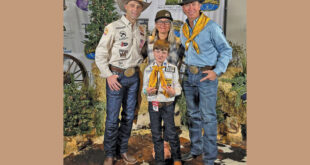Curtis Allen enrolls 2,700 acres in conservation program
A Gunnison County rancher will be the first landowner in Colorado to participate in a voluntary conservation program aimed at preserving the Gunnison sage grouse.
The Colorado Division of Wildlife has been working closely with landowners in the Gunnison Basin and other areas to help manage implementation of this conservation program administered by the U.S. Fish and Wildlife Service.
By agreeing to conservation measures, landowners who participate in the program are guaranteed that no further land-use restrictions or conditions will be required from them if the Gunnison sage grouse is ever listed as a threatened or endangered species under the federal Endangered Species Act (ESA).
The program is called a Candidate Conservation Agreement with Assurances (CCAA), and outlines conservation measures to benefit the Gunnison sage grouse while still allowing the landowners to use their lands.
Curtis Allen operates a 4,200-acre ranch that is located in the Ohio Creek Valley, just north of Gunnison. A sage grouse mating area, known as a lek, is located on his property and the ranch provides excellent year-round habitat for the birds.
Allen enrolled 2,700 acres in the CCAA program. The ranch is also adjacent to other ranches that have excellent grouse habitat. For several years Allen has worked with the DOW to develop a wildlife management plan on the property conducive to sage grouse, other wildlife species and his cattle operation.
“With the CCAA program, the Division of Wildlife is working cooperatively with landowners so that they can continue their activities in a way that enhances the survival of Gunnison sage grouse,” said Tom Remington, director of the Colorado Division of Wildlife.
The CCAA program in the Gunnison area was started three years ago by the Division of Wildlife and the Fish and Wildlife Service as a voluntary arrangement under the ESA designed to prevent the need for listing through preventive conservation efforts.
The DOW has worked closely with the Fish and Wildlife Service to develop the program and to assist landowner participation. Some 100 landowners submitted initial applications for properties that represent about 100,000 acres.
The DOW has conducted on-site inspections of about 30 properties so far to determine if they are located in important habitat areas that would aid Gunnison sage grouse. DOW and Fish and Wildlife Service officials expect to sign up more landowners throughout 2009.
Under the agreement, Allen will continue to maintain and manage water and range resources on the property to benefit both livestock production and Gunnison sage grouse brood rearing. The enrollment will be in effect until the CCAA expires in 2026.
“Allen’s property is a key parcel because it allows the birds to move around the Ohio Creek valley,” said Gary Skiba, senior wildlife conservation biologist for the DOW in southwest Colorado. “He also utilizes rotational grazing for livestock that allows for development of a great variety of grasses and forbs which provide critical cover and food for sage grouse.”
The Gunnison sage grouse currently exists in seven populations, six in Colorado and one in Utah. These include the Gunnison Basin, San Miguel Basin, Monticello-Dove Creek, Piñon Mesa, Crawford, Cerro Summit-Cimarron-Sims Mesa and Poncha Pass populations. The Gunnison Basin population is the largest.
 The Crested Butte News Serving the Gunnison Valley since 1999
The Crested Butte News Serving the Gunnison Valley since 1999


